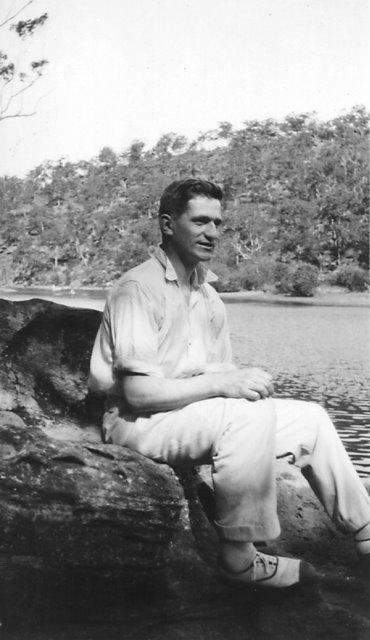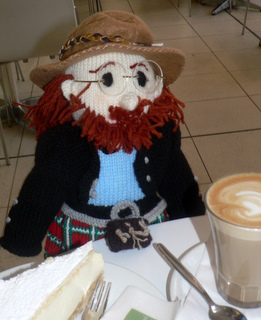A Memoir of John E. KindlerH.C. Wight, 1993J.E. Kindler concluded his four year course at the University of Adelaide at the end of 1927. He was then the Guest of Honour, at a Complimentary Dinner, hosted by some citizens (dare I say worthy burghers) of Nuriootpa. As a representative of John’s fellow students, I, the writer of this memoir, was honoured to be present. The printed programme of the Dinner, with signatures, was kept and treasured for many years. It then occurred to me that the programme might better kept at Nuriootpa, and it was transferred there by the courtesy of Mr. Ian Brook, of Angaston. The acceptance of the programme was accompanied by a request for some particulars of John’s life and career. This request I am glad to receive and act upon, to keep the memory of so worthy a fellow alive (pardon me, Heminges and Condell). I must say that what follows has been compiled entirely from memory. So, some statements made and dates given, seemingly quite confidently, may be wrong. It is possible that readers may be able to make necessary corrections — they are quite free to do so. Johannes Ernst Kindler
Sydney, 1928John (or Jack) was born at Nuriootpa in South Australia’s Barossa Valley in 1906. His father was a (or the) blacksmith of the town. John had a brother, Victor, who became a school teacher, and a sister Elma, who married a Post Master and lived among other places at Nuriootpa, Mount Barker and North Adelaide. John passed through the local primary school and when the time came gained the Qualifying Certificate. This opened the door to a High School — the nearest one — at Gawler, about 20 miles away. Thither John went for three years, sometimes, he assured me, by bicycle. Then John faced a situation common to country students at the time. To enter the Adelaide University — and his scholastic achievements suggested such a move — another year of High School was necessary. And there was only one High School in S.A. to offer this “Leaving Honours” year. So during 1923 John boarded with relatives in the St. Peters area, and attended A.H.S. where we met. On the results of the L.H. exam the Government awarded a bursary to each of the first 12 place-getters, in a Faculty of his/her choice. A.H.S. had a good year in 1923. Eight of the first 12 were A.H.S. students (including the first five) and J.E.K. was one of the 12. The future looked bright for John to pursue his chosen career, Engineering, Civil. But another situation had arisen. John’s father had died; the family financial situation became difficult. The Bursary covered all education fees and provided a cash allowance of 60 pounds per annum for books. But the family could not provide board and living expenses for four years. It was then in the time of crisis that something of a miracle occurred. Some citizens of Nuriootpa (the worthy burghers aforementioned) decided to supply John’s living expenses for four years. So board was arranged (at St. Peters again) and John embarked on his course of four years study leading, after some practical experience, to a B.E. degree. He soon was noted as a serious student, wholly devoted to study and to passing exams, usually with Credit. At the end of the school year 1926, John, with three fellow students, worked for three months with the B.H.P. at Whyalla and Iron Knob. The then method of transport to Whyalla was: - Train, Adelaide to Port Pirie 7.30AM to 5.00PM, changing trains (and gauges) at Hamley Bridge.
- Overnight in a Port Pirie hotel.
- Next morning, 7.00AM, passage in Steam Tug “Leveret” across the Gulf. The voyage took three hours if the tug was unburdened or five hours if the tug had to take the water barge across.
One half of the water used at Whyalla and Iron Knob came over in this barge; the remainder was provided by a sea-water distilling plant. For the journey, the barge was lashed securely to the side of the tug, not towed in the more usual way. It took years for me to find out why this was so. During his three months on Eyre Peninsula, John became seriously ill, but recovered when he returned to the more familiar climate, food and water of Adelaide. John completed his course at the end of 1927. I am sorry I cannot say just how many of his 24 subjects he passed with Credit, but it was a goodly number. At this time the Sydney Harbour Bridge was in its early stages of building, and the N.S.W. Government set up a Department to check the Contractors’ calculations. John received an appointment in the Department. During his work John developed and wrote a Thesis on “Secondary Stresses in Bridge Structures”, and submitted this work to the Adelaide University as an entrant for the 1928 or 1929 “Angas Engineering Scholarship”. Professor Robert W. Chapman (later Sir Robert) privately told John that his entry had been outstandingly the best submitted, but — the A.E.S. was something that was not known or recognised outside S.A., and in any case there were limitations as to the person who might receive the award — but if John could find the fee, 25 pounds, and submit the Thesis for a Master of Engineering degree, then the Professor thought it might succeed. So John paid the fee and gained his M.E. which was of immense benefit to him thereafter. On the bridge, when the last pieces of steel had been placed in position, the two halves, held by their cables, were one foot apart, awaiting the time when the cables were eased, ever so gently, until the two halves touched and were joined. While the 12 inch gap existed John stood up there, one foot on each side, the only link between the two halves. He showed me a photo of this feat. At the conclusion of the Bridge project, the Department was abolished and one of the Bridge men (Storey?) went to Brisbane to build their bridge. And took John with him. And so began John’s career, first as a senior member of the Queensland Civil Engineering Department. Before leaving Sydney, John met, and married, Kit. Kit was a beautiful young lady with (to John) the added attraction of beautiful auburn hair. John’s secret (except to me) hope was that in the fulness of time he might be blessed with two or three daughters, beautiful like their Mother and especially with auburn hair. Alas for his hopes. He did have two beautiful daughters, like their Mother, but not as to hair. They had John’s complexion and black hair. Queensland is blessed with many rivers which run into the sea and which for ease of land communication need bridges. So work was a-plenty. Following the failure of a bridge in Melbourne (not the Westgate), a Committee of Enquiry was set up, John being a member. The only comment he would make to me was “he would never use two new methods in the one structure”. John suffered attacks of migraine. On one occasion, I went to Mt. Barker to see him, but in vain; he was prostrated in a silent dark room. He had also a painful hip condition for which he consulted (in Brisbane) an American chiropractor. The American quickly found that the long-term effect of a fall while playing school football was the cause of the hip pain. He then moved his fingers up towards the neck, and suddenly said, “Do you have migraine attacks?” John replied with a heartfelt yes, whereupon the medical man got to work, and after a short time said, “You won’t have any more attacks”. And John did not. More serious was the heart condition (there is a feeling that all the family, except Mother, suffered thus). John had one attack while visiting Adelaide and had to lie still in Memorial Hospital while Kit went home to Queensland alone. John later flew home, using a fork lift to board the plane. The Church that John attended was either a-building, or having new seats. In either case, a pew designer was needed — John. He designed wooden pews on which a worshipper could sit comfortably for one hour without moving or wriggling. John’s end came with dramatic, if not unexpected, suddenness. The top Engineer in the Queensland Government service was about to retire and John as No. 2 was expected to be appointed. John went to his office one day when his appointment was expected to be announced, but at five minutes after nine o’clock, the last and fatal heart attack occurred and John died. | 


